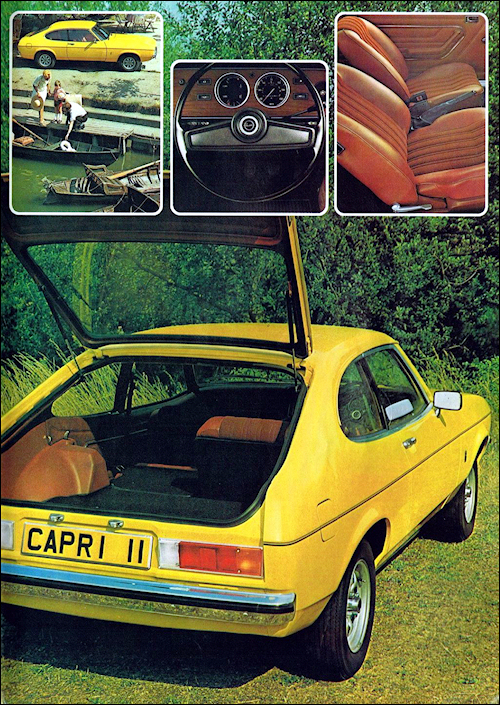Classic Cars, Movies, Music, and Other Stuff ...
In 1964, the Americans had a winner in their new affordable pony car, the Ford Mustang. With this in mind, the British and German divisions decided they would create their own version of an affordable, fun car for the European driver. And they did this by developing the Ford Capri – a car that offered “fun for the common man.”


Ford’s British and German division is turning out popular cars after World War II. I’ve touched on a few of them before. But after the runaway success of the Mustang, they also start working on a similar car for the European consumer. Why should the Americans have all the fun? While there are many family cars in the European stable, there is need for one that is sporty, yet affordable. A European pony car. And thus, in 1965, began the development of one such car.
However, the European version would need its own individuality. There are already platforms available in Europe and they would be the basis for this new car. And the Ford Cortina appears to fit the bill.
The Ford Cortina is one of the big successes for the British Ford division. I haven’t touched on this model yet. Which is unfortunate as that would have been a good foundation to start talking about the Capri from. It is one model up from the Ford Escort – which is the smallest of the Fords in Britain at the time.
The Ford Cortina is also mechanically closest to what they have in mind for the new pony car. Also, the Lotus Cortina already has the reputation for being the sporty member of the British Ford family.
The development work for the new car starts in England and Germany in the mid-60s, and is completed by 1968.
“Colt” is considered for the name of the yet unnamed model, as a nod to the American Mustang. But unfortunately, that name has already been registered by Mitsubishi of Japan. So, the Capri name, already existing in the Lincoln/Mercury division is adopted.
The car is launched in early 1969, and receives a favorable reception. It is lively, and affordable for a wide spectrum of buyers. To ensure this, it is made in a wide range of configurations. Talking about the mechanical details can get quite complex, and that’s something I avoid. However, all Capris come in a two door, coupe, 2+2 seating, rear-wheel drive, manual transmission format. What I like most about the Capri, and made it stand out, is its looks. The collaboration pays off and we are rewarded with a Ford unlike any other: the Capri Mk I!




“With its coupe design, and sporty looks, including sports rims, the Ford Capri proclaims: ‘I am a fun car.'”
We can’t go on without touching on at least some of the Capri specifications. The engines range from 4-cylinder 1.3 to a 2.3 Liter, and 6-cylinder models with 2, 2.3, and 3-Liter versions. Understanding the engine configurations is further complicated by the different engines used not just in Britain and Germany, but also in the individual plants in these countries. And these variations continue to grow.
In 1970, a slightly upscale model with better interior finishing is introduced. The Capri is assembled in the UK, Germany, Australia, and South Africa. It is promoted in the UK as: “the car you’ve always promised yourself.” In 1970, the Ford Capri hits North American shores in Lincoln-Mercury dealerships without the “Ford” badge. It is marketed here as “the sexy European.”
OsbornTramain / YouTube.com
The Capri is further updated in 1972 with improved lights, better suspension, and more comfortable seats.
Updates done to the Ford Capri on the Mk II include a hatchback design, with a third door. This is the first Ford model with this design. Others include a bigger body, better dashboard, shorter hood, smaller steering wheel, and improved reliability. Automatic transmission becomes available with all, but the smallest 1.3 Liter models.


The Ford Capri is a car that stands out on the streets for its sporty looks. With its coupe design, and sporty sports rims, the Ford Capri proclaims: “I am a fun car.” You need to put yourself back on the roads of the time to understand what this means. Cars then were mostly family sedans or station wagons. This was the only “fun” car that could also claim being a “normal” commuter car. Its 2+2 configuration also distinguished it from the pure 2-seater sports cars.
So popular is the Capri at the time, some limited editions are also produced. These include special engine configurations and external finishes.
People order these to stand apart. One of these is the John Player Special which only comes in black or white paint with gold stripes to acknowledge the JPS racing cars of the time. Inside, there are all kinds of upgrades as a reminder you are driving a customized model.
So the Ford Capri could be bought as a simple 1.3 Liter for the budget conscious, to the highly expensive customized versions for the relatively wealthy.
The energy crisis of the early 70s also had an impact on the Ford Capri as fuel saving became the norm to the detriment to fun cars everywhere.
Mechanics aside, I think the earliest external design of the Capri is the best. And I especially think the Mark III is not nearly as cool looking. This could be because all manufacturers, by the late 70s, are releasing their versions of a “fun” fastback. Even the Ford Escort had by then, dare I say, a sporty look. I’m sure the purists who are into performance will disagree with me here.
FordHeritage / YouTube.com
Anachronistic Anarchist / YouTube.com
But there’s no doubt about one thing: The Ford Capri, inspired by the Mustang, created a new genre of cars that manufacturers emulated the world over. I’ll talk about those another time.
Your comments and concerns are welcome below.
Check Out These Three “Coins in The Fountain”
Three Popular Vehicles With A Military Background
Portable Tire Inflator – Good to Get One
Thaps On The Cars of Our Lives